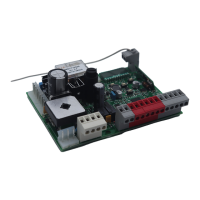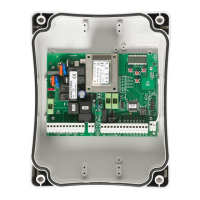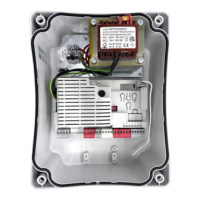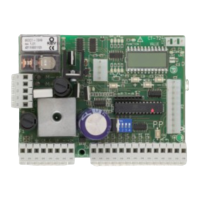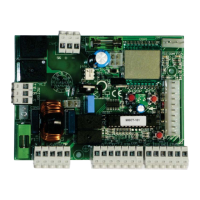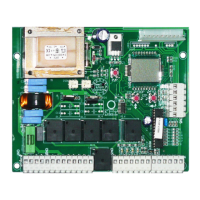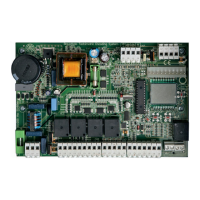8
IT
4.3 - Autoapprendimento della corsa
La prima volta che la centrale viene alimentata dev’essere eseguita
una procedura di auto apprendimento che permetta di rilevare dei
parametri fondamentali quali la lunghezza della corsa e dei rallen-
tamenti.
Premendo i tasti + o - si può leggere, oltre allo stato della centrale
come da prima tabella del paragrafo 4.2, il conteggio delle manovre
eseguite. Nella visualizzazione delle manovre si alternano le miglia-
ia, indicate senza i punti e le unità, indicate con dei punti tra di esse
(esempio: 50.000 = 50/0.0.0).
Anomalie di funzionamento
In questo paragrafo vengono elencate alcune anomalie di funzionamento che si possono presentare.
ALLARME SOVRACCARICO IMPULSIVO La corrente del motore e’ incrementata molto rapidamente
EFO
1. Il cancello ha colpito un ostacolo.
2. Ci sono attriti sulla guida o sulla cremagliera.
ALLARME COSTA SICUREZZA La centrale ha rilevato un segnale dalla costa sicurezza
EED
1. La costa di sicurezza e’ premuta.
2. La costa di sicurezza non e’ collegata correttamente.
ALLARME FINECORSA I necorsa non funzionano correttamente
ELS
1. I necorsa sono danneggiati.
2. I necorsa non sono collegati.
3. Vericare il tempo di movimentazione trascorso senza che i necorsa siano stati
impegnati
ALLARME FOTOCELLULE Il fototest ha dato esito negativo
EPH
1. Controllare i collegamenti delle fotocellule.
2. Vericare il corretto funzionamento delle fotocellule.
INTERVENTO TERMICA ELETTRONICA Mancato assorbimento di corrente del motore
Eth
1. Vericare gli assorbimenti del motore.
2. Controllare che la corsa sia uida e libera dagli ostacoli.
UP
SBS
DOWN
MENU
AUTOAPPRENDIMENTO DELLA CORSA E DEI PARAMETRI PRINCIPALI, CON
RALLENTAMENTI PREIMPOSTATI
I rallentamenti saranno quelli impostati da menù con la medesima percentuale sia in apertura che in chiusura.
Se si desidera programmare manualmente anche i rallentamenti passare direttamente alla tabella successiva.
1. Sbloccare il cancello o la porta, portarlI in posizione centrale e ribloccarlI . Se si desidera programmare
anche i rallentamenti in maniera personalizzata passare al paragrafo successivo.
2. Premere CONTEMPORANEAMENTE i tasti + e MENU per più di 5 secondi no a visualizzare LOP e pre-
pararsi a premere (se necessario) il tasto DOWN (vedi gura).
3. Se la prima manovra NON è un’apertura premere il tasto DOWN per fermare l’autoapprendimento.
Premere quindi SS in modo da far ripartire l’acquisizione: il cancello riprende a muoversi in senso corretto. Il
motore apre a bassa velocità no al raggiungimento del necorsa di apertura (se la coppia non fosse
sufciente per muovere il cancello eliminare i rallentamenti da menu [LSI=0]). Al raggiungimento del necorsa
di apertura il cancello riparte nella direzione di chiusura a velocità piena visualizzando LCL.
4. Attendere che vengano compiute due manovre complete (2 aperture e 2 chiusure) e che il cancello termini
la corsa in posizione di chiusura (visualizzando --).
5. Effettuare alcune manovre di apertura, chiusura e stop improvviso vericando il sistema sia solido e che
non vi siano difetti di montaggio.
Tutti i parametri principali sono congurati di default dalla centrale. Per personalizzare l’installazione procedere con il prossimo paragrafo 4.4.
Dopo aver rimosso la condizione di allarme, per cancellare ogni
segnalazione di errore basta semplicemente premere il tasto
“DOWN -” oppure premere il comando SBS (PASSO PASSO)
Il display ripristina le normali indicazioni.
